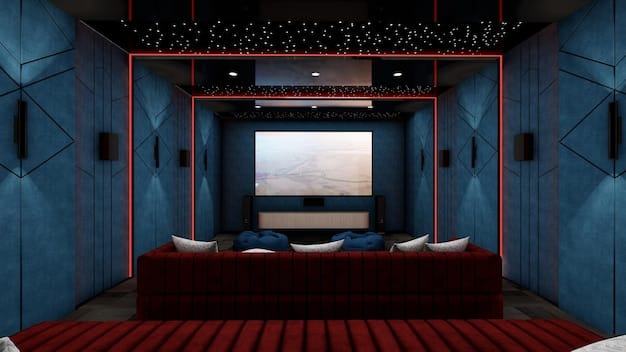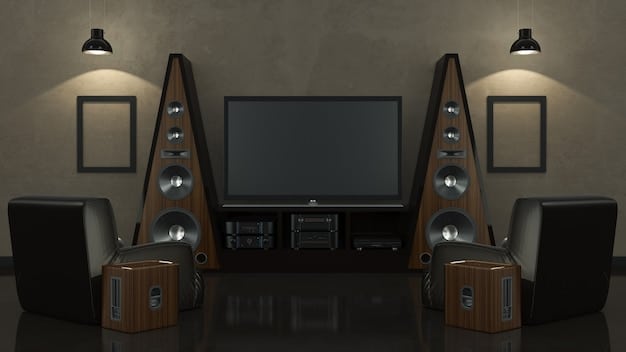Smart Home Entertainment: Create Your Ultimate Home Theater

Creating the ultimate home theater experience involves careful planning and integration of smart home technology to enhance audio, video, lighting, and comfort, providing an immersive and personalized viewing environment.
Transforming your living room into a state-of-the-art home theater is now easier than ever with the integration of smart home technology. Let’s explore how to **smart home entertainment: create the ultimate home theater experience** that rivals any cinema.
Planning Your Smart Home Theater
Creating a smart home theater begins with careful planning. Consider the room’s size, layout, and ambient lighting. Proper planning ensures that all components work together seamlessly, providing the best possible entertainment experience.
Room Dimensions and Layout
Assess the dimensions of your room to determine the optimal screen size and seating arrangement. A well-proportioned layout ensures comfortable viewing angles and balanced sound distribution.
Ambient Lighting Control
Controlling ambient light is crucial for a home theater. Smart lighting solutions allow you to dim or completely block out external light, enhancing the viewing experience.
- Blackout Curtains: Install blackout curtains to eliminate external light sources.
- Smart Lighting: Use smart bulbs that can be controlled via voice or app to set the perfect mood.
- Dimming Systems: Integrate a smart dimming system for gradual light adjustments.
Proper planning sets the stage for an immersive and enjoyable smart home theater experience.

Choosing the Right Display
The display is the centerpiece of your home theater. Consider factors such as screen size, resolution, and technology. The right display ensures a visually stunning experience.
Screen Size and Resolution
Select a screen size that is appropriate for your room’s dimensions and viewing distance. Higher resolution displays, such as 4K or 8K, provide sharper and more detailed images.
Display Technology
Choose between OLED, QLED, or LED displays based on your budget and desired picture quality. OLED displays offer superior black levels and contrast ratios.
Selecting the right display is essential for a visually immersive smart home theater.
Optimizing Audio Performance
High-quality audio is just as important as the display. Consider surround sound systems, soundbars, and acoustic treatments to optimize audio performance. Immersive audio enhances the overall viewing experience.
Surround Sound Systems
Invest in a surround sound system with multiple speakers to create a realistic and immersive audio experience. Consider Dolby Atmos or DTS:X for enhanced surround sound.
Acoustic Treatments
Improve the acoustics of your room by using acoustic panels, bass traps, and diffusers. These treatments reduce unwanted reflections and improve sound clarity.

Integrating Smart Home Devices
Smart home devices can significantly enhance your home theater experience. Integrate smart lighting, universal remotes, and voice assistants for seamless control.
Smart Lighting Integration
Use smart lighting to automatically adjust the lighting based on the movie being played or the time of day. Integrate with voice assistants for hands-free control.
Universal Remotes and Voice Assistants
Use a universal remote or voice assistant to control all your devices with a single command. Simplify your home theater setup and enhance convenience.
- Voice Control: Use voice commands to turn on/off devices, adjust volume, and control lighting.
- Remote Control: Program a universal remote to control multiple devices seamlessly.
- Smart Hubs: Utilize smart hubs to connect and manage all your smart home devices.
Integrating smart home devices enhances the convenience and automation of your home theater.
Comfort and Seating
Comfortable seating is essential for an enjoyable home theater experience. Choose reclining seats, comfortable couches, or dedicated theater seating for optimal comfort.
Reclining Seats and Couches
Select reclining seats or couches with adjustable headrests and lumbar support for enhanced comfort during long movie sessions.
Dedicated Theater Seating
Consider dedicated theater seating with built-in cup holders and storage for remotes. These seats are designed specifically for home theater use.
Comfortable seating enhances the overall enjoyment of your smart home theater.
Network and Connectivity
A stable and reliable network is crucial for streaming high-quality content. Ensure you have a strong Wi-Fi signal or hardwired Ethernet connection for seamless streaming.
Wi-Fi and Ethernet
Use a high-speed Wi-Fi router or a hardwired Ethernet connection to ensure smooth and uninterrupted streaming of 4K or 8K content.
Smart Device Compatibility
Ensure that all your smart devices are compatible with your network and can communicate with each other seamlessly. Use a reliable smart hub to manage your devices.
Reliable network connectivity is essential for a seamless smart home theater experience.
Calibration and Optimization
Proper calibration and optimization of your display and audio system are essential for achieving the best possible picture and sound quality. Use professional calibration services or DIY tools to optimize your setup.
Professional Calibration Services
Hire a professional calibration service to fine-tune your display and audio system for optimal performance. Professionals use specialized equipment and software to achieve accurate results.
DIY Calibration Tools
Use DIY calibration tools such as calibration discs and smartphone apps to make basic adjustments to your display and audio system. These tools can help improve picture and sound quality.
Calibration and optimization ensure that your smart home theater delivers the best possible entertainment experience.
| Key Point | Brief Description |
|---|---|
| 💡 Ambient Lighting | Smart lighting solutions can enhance the viewing experience. |
| 🔊 Audio Performance | Surround sound systems and acoustic treatments are vital. |
| 📺 Display Choice | OLED, QLED, or LED; pick the right one for your needs. |
| 💺 Seating Comfort | Reclining seats and dedicated theater seating options. |
Frequently Asked Questions
▼
The ideal screen size depends on your viewing distance and room dimensions. Generally, a larger screen provides a more immersive experience, but ensure it fits comfortably within your viewing area.
▼
Use blackout curtains, smart lighting, and dimming systems to control ambient light. Smart lighting can be automated to adjust based on the content being viewed or the time of day.
▼
A surround sound system with multiple speakers is ideal for an immersive audio experience. Consider Dolby Atmos or DTS:X for enhanced surround sound capabilities and acoustic treatments.
▼
Integrate smart lighting, universal remotes, and voice assistants for seamless control. Use a smart hub to connect and manage all your smart home devices for enhanced functionality.
▼
A stable network is crucial for streaming high-quality content. Ensure you have a strong Wi-Fi signal or hardwired Ethernet connection to prevent buffering and interruptions during playback.
Conclusion
Creating the ultimate smart home theater involves careful planning, selection of the right components, and seamless integration of smart technology. By focusing on display quality, audio performance, comfort, and connectivity, you can transform your living room into a cinematic paradise.





